Decorative concrete countertops have emerged as a popular option in modern kitchen and bathroom design, offering both aesthetic appeal and durability. Unlike traditional countertop materials like granite or quartz, decorative concrete can be fully customized to suit personal tastes and design preferences, making it an excellent choice for homeowners looking for unique, one-of-a-kind surfaces. Concrete countertops are created by pouring a specially formulated mixture of cement, aggregates, and water into custom molds. The surface can be stained, stamped, or textured to create a wide range of finishes, from sleek and modern to rustic and industrial. As a versatile material, concrete allows for the incorporation of decorative elements such as embedded stones, glass, or even metal objects, giving homeowners unlimited design possibilities.
One of the key benefits of decorative concrete countertops is their versatility. Concrete can be shaped and molded to fit any space, whether it’s a traditional rectangular countertop or a more complex, custom design. This allows for countertops that can incorporate integrated sinks, backsplashes, and even decorative edges. Additionally, concrete can be colored using pigments, stains, or dyes, enabling homeowners to create countertops in nearly any shade to complement their overall interior design. Whether you’re aiming for a minimalist, modern look with smooth, monochromatic surfaces, or a more textured, earthy aesthetic, decorative concrete can achieve it.
Durability is another significant advantage of concrete countertops. Once sealed properly, concrete is highly resistant to heat, scratches, and stains, making it a practical choice for kitchens and bathrooms. It can withstand the rigors of daily use, including food preparation, hot pans, and heavy appliances, without showing wear and tear. Properly sealed concrete countertops are also resistant to moisture, making them suitable for areas around sinks and other water-prone zones. However, like other natural materials, concrete can develop a patina over time, which adds to its unique character.
Another attractive feature of decorative concrete countertops is the wide range of finishes that can be applied to the surface. Polished concrete, for example, creates a smooth, glossy surface that reflects light and gives the countertop a sleek, modern look. Alternatively, a matte or honed finish can create a more understated, rustic appearance that pairs well with natural or industrial-inspired designs. Textured finishes, including stamping and engraving, add depth and interest to the countertop, making it a true focal point in any room. Homeowners can also experiment with exposed aggregate finishes, where small stones or other materials are revealed on the surface for a unique tactile quality.

Customizability is one of the biggest draws of decorative concrete countertops. Because the material is mixed and poured on-site or in a specialized workshop, homeowners can work with designers to create a truly personalized surface. This might include incorporating specific color patterns, embedding decorative materials like recycled glass or shells, or using custom molds to achieve unique shapes. Unlike prefabricated countertops, which come in limited sizes and styles, decorative concrete is tailored to the exact specifications of the space, ensuring a perfect fit and finish.
Maintenance is a crucial consideration with decorative concrete countertops. While concrete is durable, it is naturally porous, which means it needs to be sealed properly to prevent staining and water absorption. A high-quality sealant will protect the surface from spills, heat, and daily wear and tear, but it will need to be reapplied periodically to maintain its effectiveness. In addition to sealing, routine cleaning with mild soap and water will help preserve the appearance of the countertop. Harsh chemicals should be avoided, as they can damage the sealant and the concrete underneath.
In terms of sustainability, decorative concrete countertops offer several eco-friendly advantages. Concrete is made from natural materials, and many manufacturers incorporate recycled aggregates or byproducts into their concrete mixes. This reduces the environmental impact of producing the countertops. Additionally, because concrete countertops are often made locally and custom-designed for each project, they require less transportation compared to mass-produced materials, further reducing their carbon footprint. With a long lifespan and the ability to be refinished rather than replaced, concrete countertops can contribute to sustainable building practices.
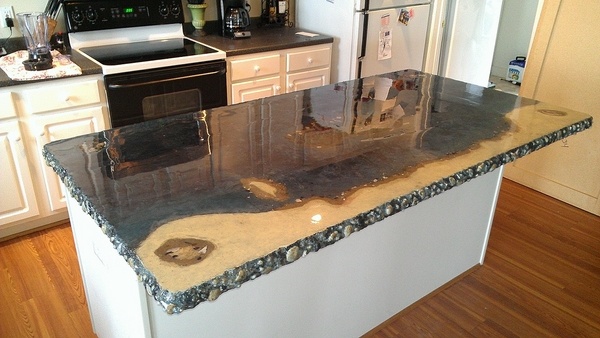
The aesthetic flexibility of decorative concrete countertops is unmatched by many other materials. Concrete’s natural color is a light gray, but it can be tinted with pigments to achieve a variety of colors, from earth tones to vibrant shades. Acid staining can also be used to create intricate marbling or veining effects that mimic the look of natural stone like marble or granite. For a more artistic approach, designers can incorporate intricate patterns or logos into the surface, creating a statement piece that reflects the homeowner’s personality.
Despite their many benefits, decorative concrete countertops are not without their challenges. One potential issue is the weight of the material. Concrete is extremely heavy, and installing countertops made from this material may require additional structural support to bear the load. This can add to the cost and complexity of installation, especially in older homes that may not be designed to handle such heavy materials. Professional installation is often necessary to ensure the countertops are properly supported and leveled, and that the seams are smooth and barely visible.
Another challenge is the curing process. After the concrete is poured, it must cure for several days before it is ready for use. During this time, the surface is vulnerable to damage, so it must be protected from scratches, dirt, and moisture. Additionally, slight cracks can develop in the concrete as it cures, which, while generally considered a part of the material’s natural character, may not appeal to every homeowner. Proper mixing and curing techniques, along with the application of reinforcement materials like fiberglass mesh, can minimize the risk of cracking.
Cost is another factor to consider when choosing decorative concrete countertops. While concrete is often viewed as an affordable building material, the customization, labor, and finishing processes involved in creating decorative concrete countertops can make them comparable in price to high-end materials like granite or quartz. Factors such as the complexity of the design, the type of finish, and the installation requirements can all influence the overall cost. However, for homeowners who value the creative freedom and long-term durability that concrete offers, the investment may be worthwhile.
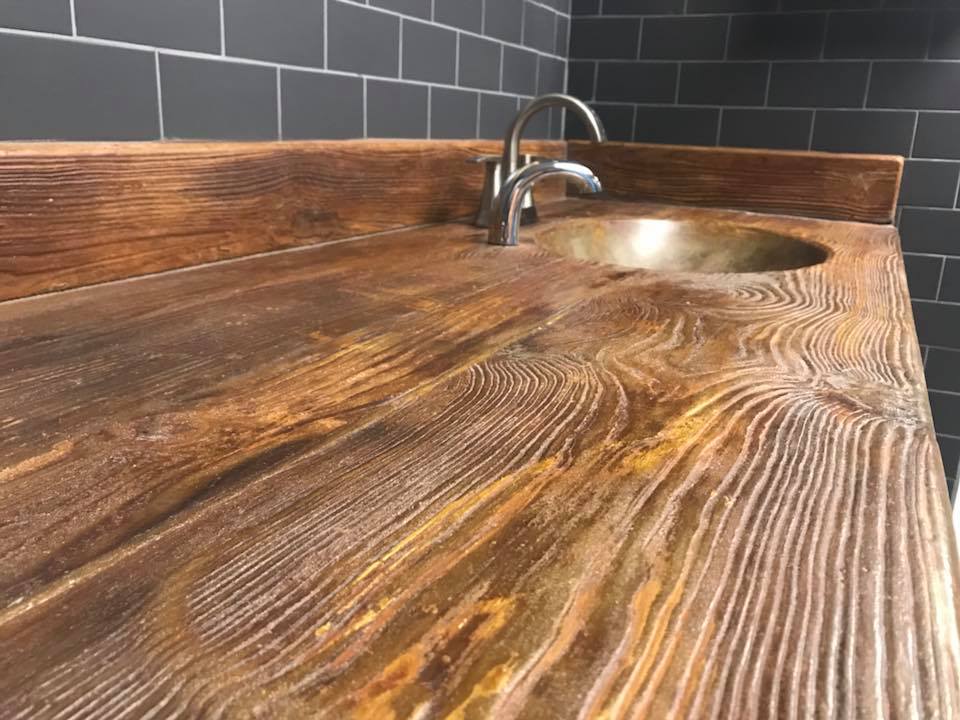
Decorative concrete countertops are also highly heat-resistant, making them ideal for kitchens where hot pots and pans are regularly placed on the surface. Unlike materials like laminate or wood, concrete will not burn or scorch from contact with high temperatures. However, it is still recommended to use trivets or hot pads to prevent the sealant from degrading over time. The heat resistance, combined with the ability to incorporate custom features like built-in trivets or cutting boards, makes concrete a functional and stylish choice for busy kitchens.
One of the less commonly known benefits of decorative concrete countertops is their ability to improve indoor air quality. When properly sealed, concrete countertops do not off-gas or emit volatile organic compounds (VOCs), unlike some synthetic materials. This makes them a good choice for homeowners looking to create a healthier living environment. Additionally, the ability to use natural, non-toxic sealers can further enhance the environmental and health benefits of concrete countertops.
The tactile quality of decorative concrete countertops is another appealing aspect. Unlike the cold, hard surfaces of granite or marble, concrete can be finished to have a softer, more natural feel. This is particularly appealing in spaces where people may spend a lot of time working or gathering, such as kitchen islands or bar tops. The ability to texture or polish the surface to varying degrees allows homeowners to control how the countertop feels to the touch, adding an extra layer of customization.
Finally, decorative concrete countertops offer a timeless aesthetic that can evolve with changing design trends. Whether you prefer a modern, industrial look or a warm, rustic feel, concrete can be adapted to suit your style. Its neutral, organic qualities make it a versatile material that complements a wide range of design elements, from wood cabinetry to stainless steel appliances. As trends come and go, concrete countertops retain their appeal, offering both durability and beauty for years to come.
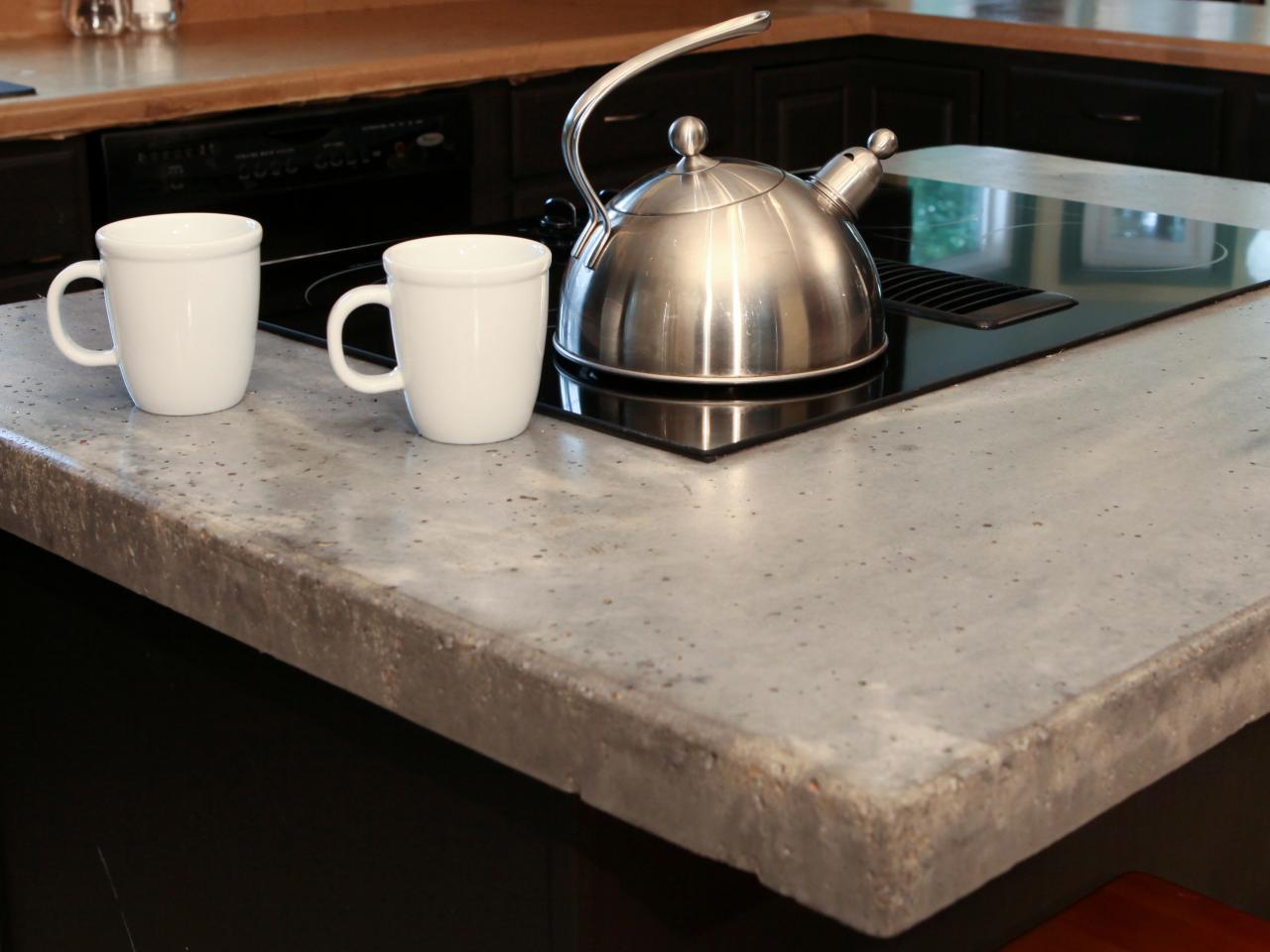
Common Mistakes to Avoid
One common mistake with decorative concrete countertops is improper sealing. Failing to apply a quality sealant or not reapplying it as needed can lead to staining, moisture damage, and even cracking. Another mistake is using harsh chemicals or abrasive cleaners, which can degrade the sealant and damage the concrete. It’s also important to avoid placing excessive weight or sharp objects on the countertops, as this can lead to cracking or scratching. Finally, a lack of proper support during installation can result in uneven countertops or sagging over time, so ensuring the base is strong enough to handle the weight of the concrete is essential.
How durable are decorative concrete countertops compared to other materials?
Decorative concrete countertops are extremely durable once properly sealed. They can withstand heat, scratches, and daily use, making them comparable to materials like granite or quartz. However, without proper sealing, concrete is porous and can be prone to staining or moisture absorption. Regular maintenance, such as resealing the surface, is essential to ensuring the long-term durability of concrete countertops.
How often do I need to reseal my decorative concrete countertop?
The frequency of resealing depends on the type of sealant used and how heavily the countertop is used. In general, it’s recommended to reseal decorative concrete countertops every one to three years. High-traffic areas, such as kitchen countertops, may require more frequent resealing to protect the surface from stains, scratches, and heat damage. Using a high-quality sealant will extend the time between resealing.
Can I install decorative concrete countertops myself?
While experienced DIYers can install decorative concrete countertops, the process can be complex and labor-intensive. Concrete is heavy, and mixing, pouring, and finishing the material requires specific skills and equipment. Additionally, proper curing and sealing are critical to ensuring the longevity and appearance of the countertop. Most homeowners choose to hire professionals to handle the installation, especially for custom designs or large surfaces.
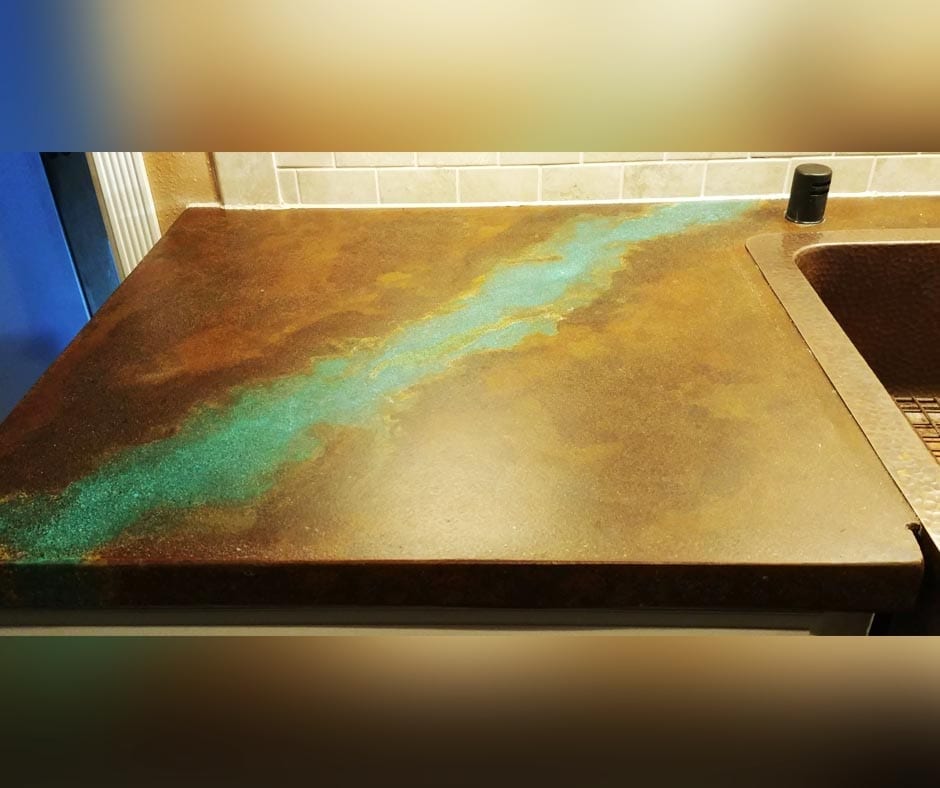
Are decorative concrete countertops prone to cracking?
While decorative concrete countertops are strong, they can develop small cracks over time, especially if not properly reinforced or installed. These cracks are often cosmetic and part of the natural aging process of the material, adding to its character. However, cracks can be minimized by using reinforcements like fiberglass mesh and applying a high-quality sealant. Proper installation and curing techniques also reduce the likelihood of cracking.
Can decorative concrete countertops be customized?
Yes, one of the biggest advantages of decorative concrete countertops is their customizability. Concrete can be shaped, molded, and colored to fit any design scheme. Homeowners can incorporate unique features like built-in sinks, trivets, or embedded materials such as glass or stones. Different finishes, such as polished, matte, or textured, also allow for further customization to match your aesthetic preferences.
Are decorative concrete countertops eco-friendly?
Decorative concrete countertops can be eco-friendly, especially if made with sustainable or recycled materials. Many manufacturers use recycled aggregates or industrial byproducts in their concrete mixes, reducing the environmental impact. Additionally, concrete countertops are long-lasting and can be refinished rather than replaced, contributing to sustainability. Choosing non-toxic, low-VOC sealers further enhances their eco-friendly benefits.
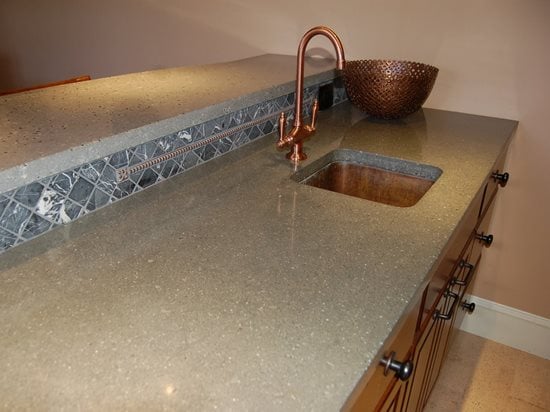
Striking Acid Stained Kitchen Countertops
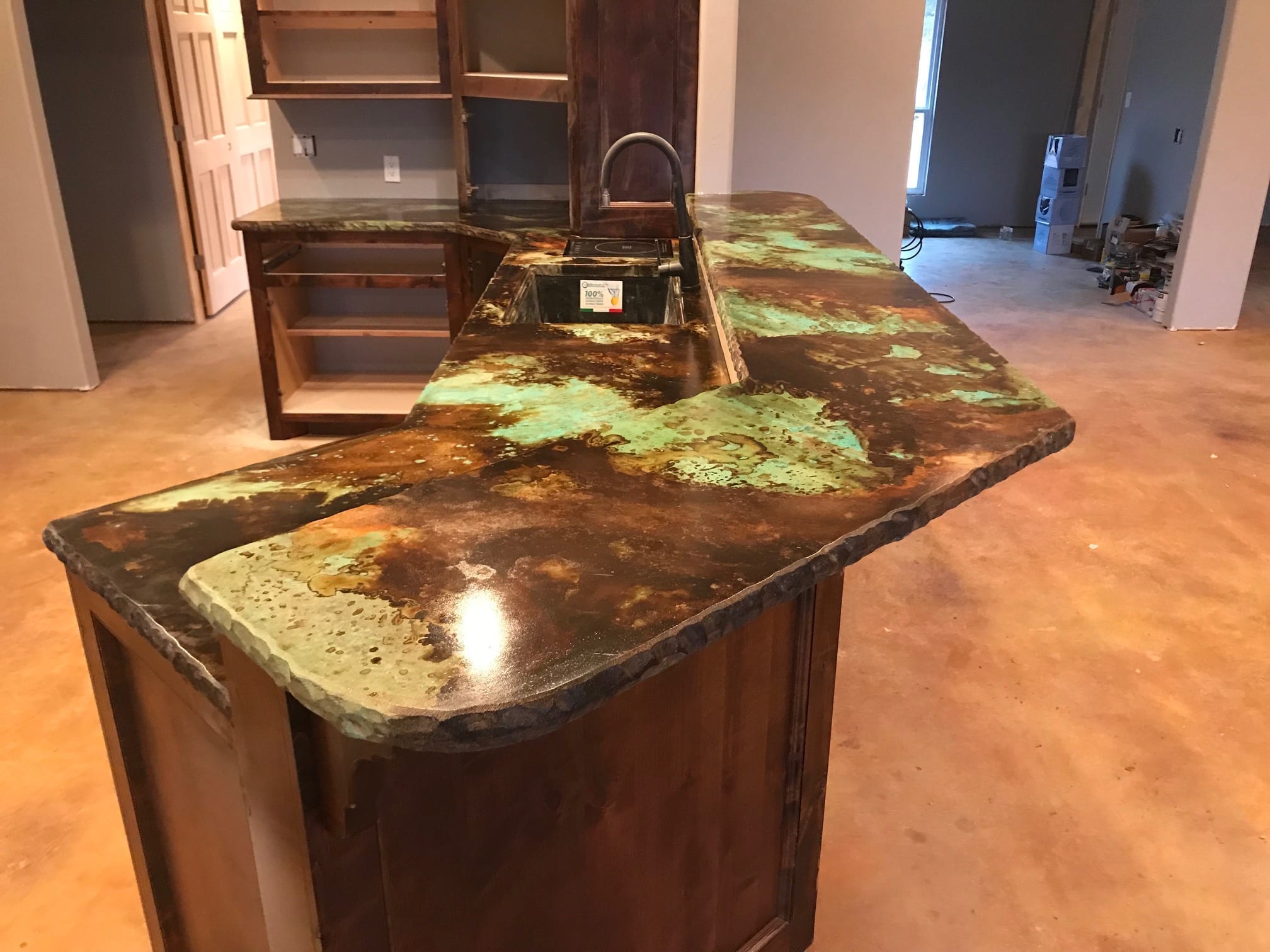
Concrete Countertops: How We Do It Decorative Concrete
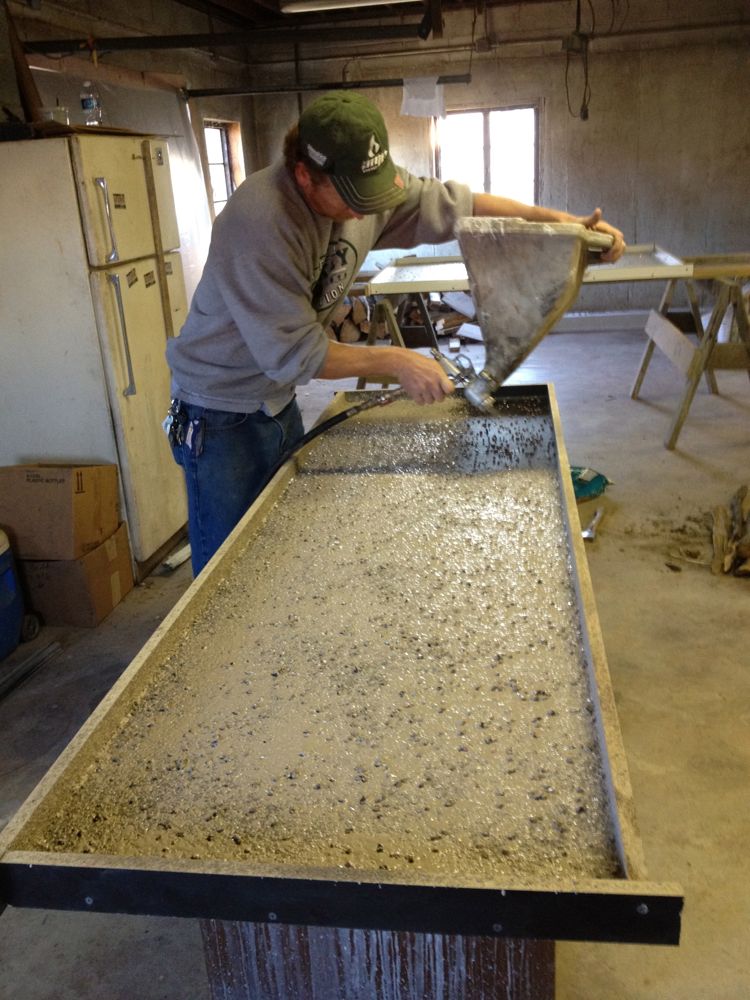
Related articles:
- How To Stain Concrete Countertops
- DIY Concrete Countertop Mix
- Concrete Countertops Made Easy
- Concrete Countertop Overlay
- Black Concrete Countertops
- Marble Look Concrete Countertops
- Light Grey Concrete Countertops
- Concrete Countertop Design Ideas
- Light Colored Concrete Countertops
- Epoxy On Concrete Countertop